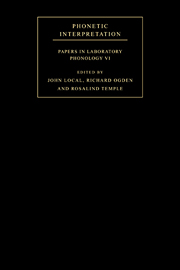Book contents
- Frontmatter
- Contents
- List of contributors
- Acknowledgements
- Introduction
- Part I Phonological representations and the lexicon
- Part II Phonetic interpretation and phrasal structure
- Part III Phonetic interpretation and syllable structure
- 11 On the factorability of phonological units in speech perception
- 12 Articulatory correlates of ambisyllabicity in English glides and liquids
- 13 Extrinsic phonetic interpretation: spectral variation in English liquids
- 14 Temporal constraints and characterising syllable structuring
- 15 Commentary: some thoughts on syllables: an old-fashioned interlude
- Part IV Phonology and natural speech production: tasks, contrasts and explanations
- References
- Index of names
- Index of subjects
13 - Extrinsic phonetic interpretation: spectral variation in English liquids
Published online by Cambridge University Press: 22 September 2009
- Frontmatter
- Contents
- List of contributors
- Acknowledgements
- Introduction
- Part I Phonological representations and the lexicon
- Part II Phonetic interpretation and phrasal structure
- Part III Phonetic interpretation and syllable structure
- 11 On the factorability of phonological units in speech perception
- 12 Articulatory correlates of ambisyllabicity in English glides and liquids
- 13 Extrinsic phonetic interpretation: spectral variation in English liquids
- 14 Temporal constraints and characterising syllable structuring
- 15 Commentary: some thoughts on syllables: an old-fashioned interlude
- Part IV Phonology and natural speech production: tasks, contrasts and explanations
- References
- Index of names
- Index of subjects
Summary
Introduction
Much recent phonology presupposes intrinsic phonetic interpretation, in which phonological features are effectively phonetic features. In an intrinsic model such as Bromberger and Halle (1989), the phonology organises the phonetics in the sense that features have binary values in phonology; the same features appear with scalar values in the phonetics. Phonological structure is effectively an arrangement of phonetic content.
Extrinsic Phonetic Interpretation (EPI) makes use of abstract phonological categories which are related to, but do not equate to, phonetic features (Local 1995a). EPI mechanisms are found in some contemporary frameworks, particularly in those versions of Declarative Phonology influenced by Firthian Prosodic Analysis (Local 1995a; Local and Simpson 1999; Ogden 1993, 1999a, 1999b; Ogden et al., 2000). In such approaches, phonology is made up not of phonetic features but of abstract relational categories primarily concerned with contrast and not uniquely associated with phonetic events. EPI forces the analyst to recognise the need for explicit phonetic interpretation. In this paper I will argue that EPI provides for a felicitous account of phonetic variation and phonological abstraction.
This paper examines the case of secondary articulations in English liquids from a declarative phonology/EPI perspective, outlining the structure-dependent and dialect-specific aspects of their phonetic implementation, thereby extending the work of Kelly and Local (1986, 1989) to rhotic varieties of English and testing the predictions made by Sproat and Fujimura (1993) against data from other varieties.
- Type
- Chapter
- Information
- Phonetic InterpretationPapers in Laboratory Phonology VI, pp. 237 - 252Publisher: Cambridge University PressPrint publication year: 2004



